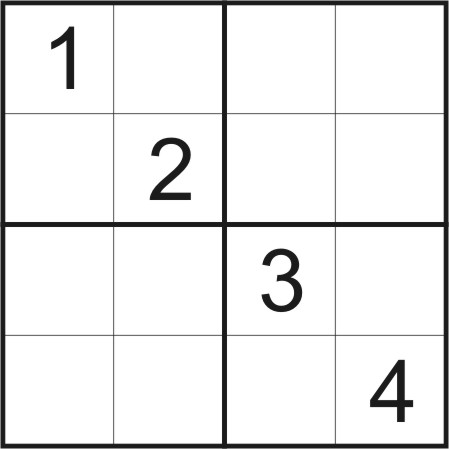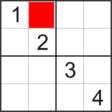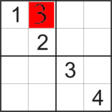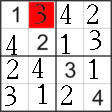Schools Mathematics Grand Challenge
Week three's Puzzles
Problem 7:
The seventh problem was:
Many of you have probably done SUDOKU puzzles before. Consider the
SUDOKU puzzle based on the grid shown below. Each horizontal row,
each vertical column and each of the four smaller grids (each containing
four squares), must contain all of the numbers 1, 2, 3, 4. Usually,
there is only one solution to a SUDOKU puzzle. However, in the
grid below, there is more than one way of completing the puzzle.
How many different completions of the grid are possible?

The solution was:
Looking at the Sudoku board below, we have to
put some number into the red box.

The 1 and 2 can't be used, because they are already
in the top-left square. So, we must use 3 or 4.
Let's try 3.

Once we put three in, we can first fill in the
top-left square completly, and from there we
can finish the problem only one way.

We then go back and try putting 4 into the red
box. It turns out that we can finish the Sudoku
problem. Since 3 and 4 are the only possible options
for the red square, and both lead us to just one
solution, there are only two ways to complete the
grid.
Problem 8:
The eighth problem was:
A large water tank in a country with a perfectly regular climate
is exactly 48 feet high. During the rainy season, each day has
exactly 12 hours of rainfall followed by 12 hours of evaporation.
The water level in the tank increases at a uniform rate of 1 foot
per hour during the 12 hours of rainfall, and it decreases at a
uniform rate of half a foot per hour during the 12 hours of
evaporation. If the tank is empty at the beginning of a 12 hour
rainfall period, how many hours will it take for the water level
in the tank to reach the top of the tank for the first time?
The solution was:
At the start of day 1 we have 0 feet of water in the tank.
After 12 hours we have 12 feet of water and at the end of
the day we have 6 feet. The pattern for day 2 is the same,
but with 6 feet extra of water.
So, on day n, we finish with 6n feet of water,
start with 6n-6 feet of water and the highest we get
to is 6n+6 feet of water, in the middle of the day.
Let's see what the first day is when we have at least
48 feet of water. For this, 6n+6 ≥ 48, so
6n ≥ 42 or n ≥ 7. So the first day that we have
at least 48 feet of water is day 7. In fact this
happens in the middle of the day.
The middle of day 7 is one half day and 6 full days
from the beginning. That's 24*6+12 hours, or 156 hours.
Problem 9:
The ninth problem was:
In English the most common letter is "E". We have made up a message
telling you how to answer this problem and in the message the most
common letter is E.
However, we have encrypted the message! For every A in the original
message, we counted forward a secret number of letters in the
alphabet and wrote that down. The same for B, and so on. While
we are doing this counting, if we get to Z, the next letter is A.
For example, if the secret number was 2, "zebra" would become
"bgdtc". This is called a Caesar Cipher after Julius Caesar who
used it to talk to his generals.
In the problem below, the secret number is not 2, it is secret!
Fqjc rb nunenw crvnb bnenwcnnw?
The solution was:
The most common letter in the encrypted message is "n", so it
must actually be "e". This means that we have to slide all the
letters back 9 places (or, equivelently, forward 17).
When we decode the message we get:
What is eleven times seventeen?
So, the answer is 187. Some people forgot to decode the message,
so we will also accept 9 and 17 as the answer. However, we'll be
stricter next time!
|